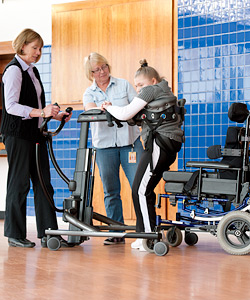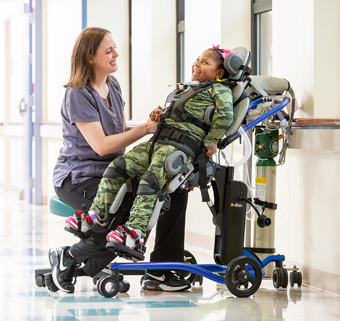SMART Goal Writing Using Adapted Equipment to Enhance Participation in Activities
| January 2013
Goal writing is central for measuring outcomes, documenting the mobility performance of a child, and securing insurance funding and reimbursement. Good goal writing supports physical therapists’ practice by objectively quantifying functional performance and achievement. With the inception of the ICF model1, therapists can focus their interventions on activities and participation in functional activities. In this article we will discuss use of the ICF model to write SMART2 (specific, measurable, achievable, relevant, time limited) goals for students using adapted equipment.
The Importance of the ICF Model
The central focus of the ICF model is on activities that a child performs and the level of the child’s participation in daily routines. This model is relevant for therapists working with students in school, community, and home settings. Below are examples of activities and participation in real life contexts. It is easy to see how participation might be enhanced when using durable medical equipment (DME). Without the use of DME, the child might never gain the potential to perform these important life skills.
The ICF model recognizes other domains that influence activities and participation. These domains are: health condition (disorder/disease), body structure and function (includes anatomy/physiology of the body), environmental factors (external forces such as society attitudes, environmental barriers, financial) and personal (race, gender, age, coping style, motivation). In order to set goals for a child, the therapist must understand the impact of these underlying components to potentially influence the activities and participation of that child.
Writing the SMART Goals
The table below reflects SMART goal writing and their attributes.3
| ACRONYM | ATTRIBUTE |
| Specific | The goal should be specific to the child, the situation and the attributes of what the child should accomplish. |
| Measureable | The outcome should be quantifiable and objective |
| Achievable | Based on prognosis and evidence, the goal should be something the child can master. |
| Relevant | The goal should be in a context of where the child performs the activity, an activity that is important for the child to achieve, and a part of their daily life. |
| Time limited | The goal should have a time measurement associated with it. |
Before the goal is written, the therapist should obtain baseline measures as the starting point. Use of SMART goals ensures that the goals will be objective and therefore easier to measure. In educational settings, goals are often used as outcome measures.
The table below showcases examples of SMART goals using adapted equipment.
| Information on the child | Specific | Measurable | Achievable | Relevant | Time limited |
| For a 4 year old child with cerebral palsy, GMFCS Level 2. Baseline: the child can do this motor skill with 5 prompts and minimal assistance | The child will walk using a walking device (gait trainer, walker, etc) | With no more than 2 verbal prompts and contact guard assistance | (Based on baseline, goal should be achievable in 1 year) | While walking with peers from the bus to the classroom | On a daily basis, 4/5 days per week as measured over a 9 week period. |
| For a 15 year old boy with a diagnosis of s/p closed head injury with baseline of able to perform task with 35% of body weight. | The child will walk 4 laps around the gym using a walking device (such as Rifton TRAM) | Independently and bearing 75% of body weight | (Based on baseline, goal should be achievable in 1 year) | While walking in PE class | On 2 of 3 days per week, as measured for one week per month. |
| For a 10 year old girl with a diagnosis of s/p closed head injury with a baseline of performing transfer with minimal assistance and 5 verbal cues for set up. | The child will transfer from wheelchair to adapted toilet seat | With contact guard assistance and no more than 2 verbal cues for set up | (Based on baseline, goal should be achievable in 1 year) | And complete toileting sequence | As measured on 4/5 days per week as measured over 2 weeks per quarter. |
SMART goal writing, in the context of the ICF model, enhances participation in activities of the child with a disability. Use of adapted equipment enhances a child’s ability and independence in performing skills. Participation in these skills ultimately gives children more opportunities for fitness, social participation in physical and recreational activity, and independence in performing life skills.
Connie Johnson is a physical therapist working for Fairfax County (Virginia) Public Schools.
1World Health Organization. (2001) International Classification Functioning, Disability and Health (ICF). Geneva: World Health Organization. Retrieved from: http://www.who.int/classifications/icf/en/.
2Bovend’Eerdt et al (2009) Writing SMART rehabilitation goals and achieving goal attainment scaling: a practical guide. Clin Rehabil 23: 352
3Kneebone (2006) Goal setting as an outcome measure: a systematic review. Clinical Rehabilitation, 20: 756-772
Additional Reference:
Kucukdeveci et al (2011) Strategies for assessment and outcome measurement in physical and rehabilitative medicine: an educational review. J Rehabil Med epub ahead of print.




